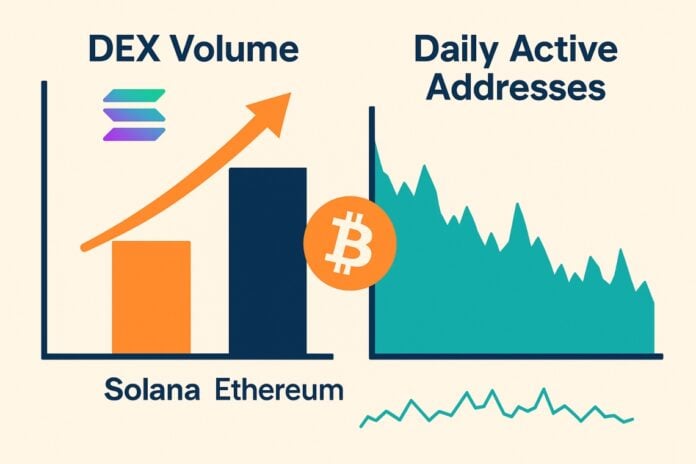In recent months, DEXs on Solana have recorded cumulative volumes exceeding those of Ethereum, while most addresses remain active for less than a day, according to on‑chain dashboards and industry analyses available on DefiLlama and Dune and in reports from financial outlets like CoinDesk (data updated as of September 7, 2025).
Record volumes and minimal costs have driven activity on Solana to its peak, consolidating the surpassing of Ethereum in DEX during several recent time frames.
At the same time, data on address churn highlight a structural friction: a hyper-transient user base, with rapid cycles and low medium-term retention. In this context, here are the numbers, method, and possible implications.
According to the data collected by our research team, aggregated from on‑chain dashboards and verified on public sources as of September 7, 2025, the DEX volume peaks on Solana have occurred over several consecutive months in 2025.
Industry analysts note that the dynamic is largely driven by very low fees and algorithmic activity (market makers and bots), rather than by a proportional increase in recurring users.
Summary
Why Volumes Are Exploding on Solana
The combination of high throughput, low fees, and quick finality facilitates high-frequency trading and a very high number of transactions per user.
- Transaction fee on average in the order of a few cents (often < $0.01 on Solana’s L2), while on Ethereum L1 the fees are significantly higher (Artemis – Solana Metrics vs Artemis – Ethereum Metrics).
- Near-instant finality and extensive network capacity create an ideal environment for market makers, bots, and high-turnover strategies.
- Result: DEX volume spikes which, while indicating strong trading activity, might reflect a less solid user base.
Analysis and data on platforms like DefiLlama and Artemis highlight periods when the monthly volumes of DEX on Solana have surpassed those of Ethereum. A comparative in-depth analysis has been covered by the specialist press and the mentioned dashboards.
Address Churn: Methodology and Results
“Churn” refers to the share of active addresses in a time window T that do not remain active in subsequent windows (24 hours, 30, 90, 365 days). This metric allows for the assessment of user retention and their potential return.
- Operational definition: starting from the cohorts defined by the first day of activity, it is measured whether an address reappears after 1, 30, 90, or 365 days on the DEX of the same chain.
- Database: on-chain events related to DEX operations (swap, add/remove liquidity) and related transactions, appropriately filtered by chain.
Diverse on-chain analyses indicate a “disposable” use of many addresses on Solana.
Reports and public dashboards show that, in selected windows of 2024–2025, over 96% of active addresses in one day do not reappear the following day (reproducible analysis on Dune), while only about 0.2% of addresses maintain activity beyond 12 months in certain analyzed cohorts (indicative value, see Cohort analysis on-chain: method and pitfalls).
It should be noted that the 30 and 90-day retention levels are low and extremely sensitive to market cycles and incentive campaigns (data subject to verification and resampling by period and included DEX list).
Key implication: high monthly volumes can coexist with fragile adoption if the share of recurring users does not grow proportionally.
The Overtaking in Volumes vs Long-Term Adoption
Solana’s overtaking of Ethereum in DEX indicates an operational superiority in high-frequency contexts.
However, the volume metric alone does not measure the quality of demand: if the majority of trades come from ephemeral addresses, the signal for the maturity of the ecosystem inevitably becomes weaker.
- Temporary activity does not equate to lasting adoption.
- Return cohorts offer a more reliable picture of sustainability compared to throughput peaks.
- A “sticky” base promotes deeper liquidity, better spreads, and more representative governance.
The Role of SOL Volatility
The volatility of the native Solana token can accentuate speculative trading.
During periods of strong price swings (also observed in 2024–2025), traders tend to favor short-term strategies and the use of disposable addresses, fueling churn and hindering the transformation of occasional users into stable participants.
Simultaneously, low fees and reduced latency attract bots and algorithmic strategies (Artemis – Solana Metrics), useful for tactical liquidity but less oriented towards building long-term utility. For intraday price and volatility data, consult market sources like CoinGecko – Solana.
KPI at a Glance
- Recent DEX Volumes: various periods show Solana with volumes surpassing Ethereum (DefiLlama – Solana, Artemis – Solana).
- Churn 24h: over 96% of active addresses in one day do not return the following day, as revealed by on-chain analysis available on Dune (data from 2024–2025, to be replicated by cohort).
- 365-day cohort: only about 0.2% of addresses maintain persistent activity in some analyzed cohorts (indicative value, subject to cohort definition and filters).
- Fee: on Solana they remain in the order of cents of a dollar, while on Ethereum L1 the fees are significantly higher.
Risks, Controversial Angles, and Open Questions
- Distortive incentives: reward campaigns can artificially inflate volumes without improving the quality of users.
- Measurement: DEX volumes do not always effectively distinguish between wash-like activity and organic trades.
- Over-representation of bots: the impact on price discovery and on the adoption narrative remains a subject of debate.
What Can Improve Retention on Solana
- Loyalty programs oriented to cohorts over time windows of 30/90/365 days, with transparent metrics and anti-gaming systems (see our guide on loyalty programs).
- DeFi Products with real utility – such as collateral, on-chain credit, or professional RFQ – that incentivize non-opportunistic lock-in.
- Simplified Onboarding thanks to an optimized wallet experience, account abstraction, and security by design (more details in the Wallet Onboarding guide).
- “Patient” liquidity: the involvement of institutional investors and market makers with multi-month time horizons could help strengthen the user base.
Methodological Note
The churn and retention rates depend on the definition of cohorts, the set of DEX included (AMM/RFQ/aggregators), and the anti-spam/bot filters applied.
The reported percentages (e.g., >96% churn in 24h, ~0.2% retention at 365 days) are derived from industry analysis and should be replicated with a clear methodology on public dashboards like Dune or Flipside Crypto for the period under review (data updated as of September 7, 2025, sampling required).
Voices and Quotes
“High volumes without returning users produce weak signals for network growth.” — a recurring summary in reports on on‑chain retention and analyses by market operators.
Useful Links
- How to read DEX volumes: metrics that matter
- Cohort analysis on-chain: method and pitfalls
Conclusions
Solana demonstrates a superior operational capacity in DEX and records growing volumes; however, user retention remains its Achilles’ heel.
The main challenge remains converting high-frequency activity into a base of recurring users, reducing churn and expanding the “core base.” In this context, the balance between low costs, an optimal user experience, and well-structured incentives will determine the long-term trajectory of the ecosystem.
Short Take
For investors: monitor the 30/90/365-day cohorts in addition to monthly volumes. For developers: focus on optimizing onboarding and anti-gaming incentives. For everyone: verify data on DefiLlama, Artemis, and Dune before drawing definitive conclusions.




